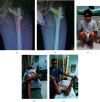Fixator-Assisted Nailing for Femur Neck Fracture Nonunion: A Case Series Study
- PMID: 35465127
- PMCID: PMC9023225
- DOI: 10.1155/2022/5676144
Fixator-Assisted Nailing for Femur Neck Fracture Nonunion: A Case Series Study
Abstract
Background: Femoral neck fractures in young adults tend to be a result of high-energy trauma with a common pattern of Pauwels type III fracture, and they require timely and meticulous diagnosis and management. The objective of this study was to assess the clinical and radiological outcomes of the fixator-assisted nailing technique for managing femur neck fracture nonunion. Methods. This was a case series study of 16 patients with nonunion femoral neck fractures treated via a fixator-assisted nailing technique. Our inclusion criteria comprised the inclusion of any patient between the ages of 14 and 60 years old with a neglected neck of femur fracture or nonunion of the femur neck. In addition, we only included patients without further posttreatment trauma and without known metabolic diseases. The conditions that were excluded from this study included hip joints with preexisting osteoarthritis, radiographic evidence of avascular necrosis of the femoral head, and associated ipsilateral acetabulum fracture or fracture-dislocation. The fracture characteristics that were selected for the fixator-assisted nailing (FAN) technique were clear signs of pseudoarthrosis (such as sclerosis, clear fracture line defects, and failure of implants), in addition to evidence of varus malalignment. All fractures were Pauwels type III. Radiographs of the pelvis with both hips and a posteroanterior (PA) view of the injured hip were taken. Full weight bearing was allowed in all the patients from the first day postoperatively. Physical therapy was started for pain reduction modalities, stretching, and abductor strengthening.
Results: Union of the femur neck fracture and osteotomy site was achieved in all patients. An excellent functional status after four months of follow-up was found based on a modified Harris hip score questionnaire. At follow-up, no patient was suffering from pain or flexion contracture. Preoperative limb length discrepancy (LLD) (cm) was 1.8 ± 0.8 cm and postoperative was 0 ± 0.1 cm, p < 0.001. Preoperative neck-shaft angle (NSA) (o) was 85.6 ± 4.4 and postoperative was 126.9 ± 2.5, p < 0.001. Preoperative Pauwels angle (o) was an average of 50.4 ± 5.9 and postoperative was 31.3 ± 2.5, p < 0.001.
Conclusion: Our study indicates that FAN has a high success rate in young patients with nonunited femoral neck fractures.
Copyright © 2022 Majdi Hashem and Mohammad S. Al-Tuwaijri.
Conflict of interest statement
The authors declare there are no conflicts of interest.
Figures




References
-
- Pauwels F. Gesammelte Abhandlungen Zur Funktionellen Anatomie Des Bewegungsapparates . Berlin, Germany: Springer Berlin Heidelberg; 1965.
-
- ELzohairy M. M., Eid A. S. Meta analysis of different methods used for joint preserving procedures in the management of delayed, neglected and non-united femoral neck fractures in young adults. Trauma . 2016;18(4):245–249. doi: 10.1177/1460408616645612. - DOI
-
- Pauwels F. The Femoral Neck Fractures a Mechanical Problem Leaflet Issue to Zeitschr F Chir Orthop . Stuttgart, Germany: Enke; 1935.
LinkOut - more resources
Full Text Sources

